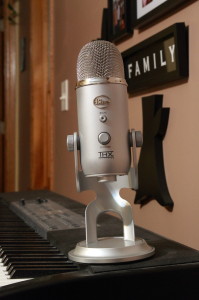The Simple Life
 I bought the Blue Yeti to simplify my life.
I bought the Blue Yeti to simplify my life.
First of all, I have a background in sound, having run concert sound for various types of gigs, ranging from bar bands, to conventions for 2000 people. I have used quite a number of mics and still have a few laying around, including an Audio Technica 4033*. It is this mic that I was still using to record, but didn’t like setting up the mic on a stand, running it to my mixer, then taking mixer to MOTU 2408 to computer. It’s just too much for a podcast, or portable applications.
So, Blue Yeti comes to the rescue. What I liked initially about the Blue is the simplicity of it. Just plug in a usb cable to a laptop and you’re recording. This mic shows up as a standard windows microphone device. It’s very easy to choose this as the input device in either the control panel or the recording app (if possible).
I am using Cool Edit 96 (yes, from 1996) to record straight audio tracks. I have also been using Sony Vegas Movie Studio to record takes when doing instructional videos for my wife.
Before I continue, a little history. I have done a bit with professional audio and recording. For those of you that know me, I was running a small sound company for a while, and I had microphones such as the $399 AT-4033 mentioned above, along with various condenser and dynamic microphones. My favorite was the AT 4033 and AT 4040 large diaphragm mics. I also liked the Shure Beta 98A mic. I’ve had the chance to play around with more expensive mics as well, but never really used the high end mics (i.e. those over $1000).
Why did I chose this USB mic? I know Audio Technica makes the AT-2020USB, and other companies also have USB mics, or XLR to USB adapters. But I know Blue makes high-end mics as well. They are one of the few that make $4000 mics as well as $100 USB mics.
HOW DOES YETI SOUND?
It sounds great. I would agree with many other reviews out there that it is a very good quality mic. I’m not going to get into how it sounds, except for that it is, expectedly, far superior to any devices built-in mics. That being said, I would have to say the recording quality is on par with my AT-4033 mic. But having multiple pickup patterns makes it much more flexible.
HOW DOES YETI WORK in different situations?
Let me explain first what I have used the Yeti for. I have used it to record instructional videos, as well as solo singing, as well as room recording (a live band). For the first few applications, it works great.
Solo Singing
The solo singing worked just fine. For the solo singing, I used the cardioid setting, had the gain about 11:00 and monitored levels on-screen. I also used the headphone jack for live monitoring with zero latency. The mic is easy to setup for solo singing. I just had the singer within 2 inches of the mic and everything was good.
Instructional Video
The instructional video also worked just fine. I again used the cardioid setting, but the gain was adjusted to about 1:00. With this situation, I was getting too much pop though. So I went and got the DIY pop filter and had my wife hold it between her and the mic. That took care of the pops. BTW the diy pop filter is a pair of women’s nylons in an embroidery hoop cut to fit. Much cheaper than spending $20 on a premade pop filter*.
Room Recording
 For the room recording, I used the stereo setting, recording to 2 tracks. I had the gain way down because the band that was playing was super loud. Here is where I ran into trouble. I was using cool edit 96, which does not have any capable monitoring system to watch levels while recording. So I had the control panel widget for the blue mic up on screen so that I could see the levels. I kept adjusting up until it almost peaked, then kept it there. The problem I found is that the I never peaked, but the final recording levels turned out compressed. Heavily compressed. This is bad.
For the room recording, I used the stereo setting, recording to 2 tracks. I had the gain way down because the band that was playing was super loud. Here is where I ran into trouble. I was using cool edit 96, which does not have any capable monitoring system to watch levels while recording. So I had the control panel widget for the blue mic up on screen so that I could see the levels. I kept adjusting up until it almost peaked, then kept it there. The problem I found is that the I never peaked, but the final recording levels turned out compressed. Heavily compressed. This is bad.
Apparently the Blue Yeti compresses the signal so that you don’t peak out in the recording application. But there is no indicator of that happening. If I knew it was doing that, I would have backed down the gain so that it wouldn’t clip the signal while recording. It is unfortunate that I had no way of knowing that the signal was being clipped before the recording app.
This is the only disappointing aspect of this mic. Now that I know, I will have to watch the levels more closely so that I leave a little more headroom, which should yield a less compressed signal.
* DISCLAIMER: THERE ARE AFFILIATE LINKS ON THESE PAGES. If you buy from these vendors, I earn a small commission from them. Please support me by purchase with these links.

